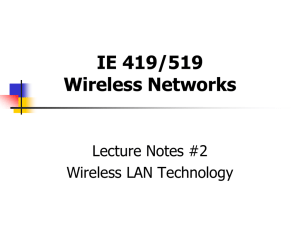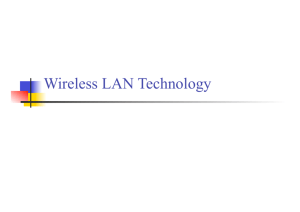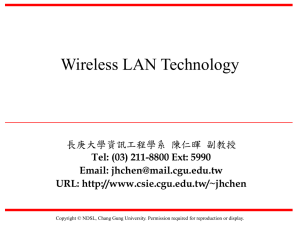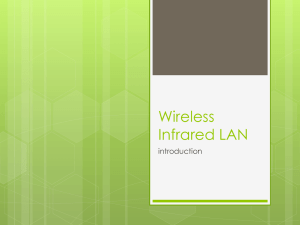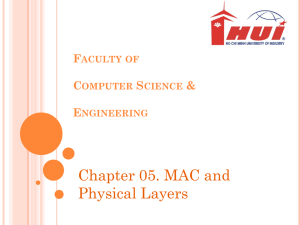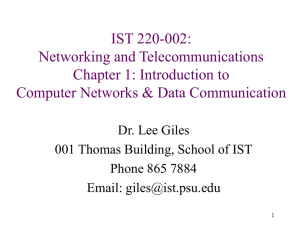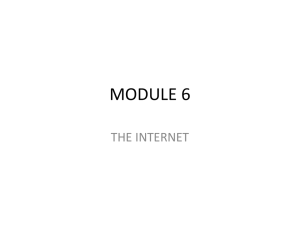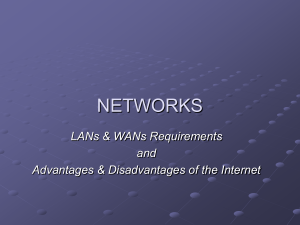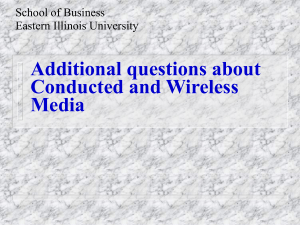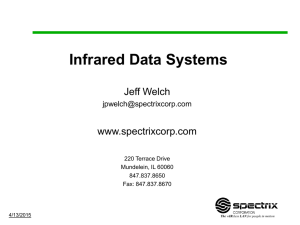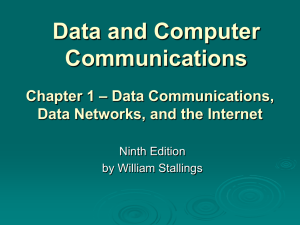Wireless LAN Technology
advertisement
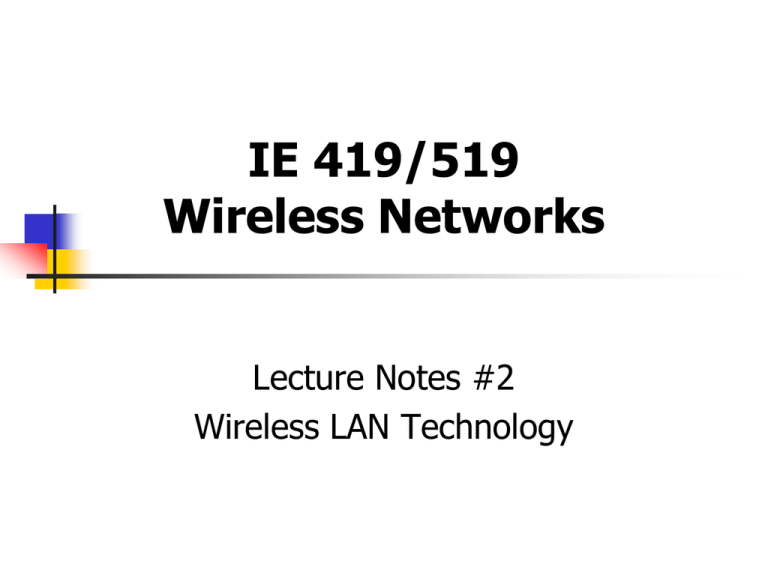
IE 419/519 Wireless Networks Lecture Notes #2 Wireless LAN Technology Wireless LAN Technology Little used earlier because of All these factors have been addressed making WLANs attractive to users 2 Wireless LAN Technology Indispensable adjunct to traditional wired LANs to satisfy requirements for: 3 Early Wireless LANs Many standards = No standards Limited or no encryption .5 to 2 Mbps throughput High NIC cost High AP cost Limited roaming 4 Modern Wireless LANs IEEE standards based 128 bit encryption ≥ 11 Mbps throughput Low NIC cost Low AP cost Integrated roaming 5 Wireless LAN Applications LAN Extension Cross-building Interconnect Nomadic Access Ad Hoc Networking 6 LAN Extension Wireless LAN linked into a wired LAN on same premises Wired LAN Backbone Support servers and stationary workstations Wireless LAN Stations in large open areas Manufacturing plants, stock exchange trading floors, and warehouses 7 Multiple-cell Wireless LAN 8 Cross-Building Interconnect Connect LANs in nearby buildings Wired or wireless LANs Point-to-point wireless link is used Devices connected are typically bridges or routers Cisco Aironet 1300 and 1400 Series Wireless Bridges http://www.cisco.com/en/US/products/ps5861/prod_brochure09186a0080230777.html 9 Nomadic Access Wireless link between LAN hub and mobile data terminal equipped with antenna Laptop computer or notepad computer Uses Transfer data from portable computer to office server Extended environment such as campus 10 Nomadic Access – Example Source: www.alliedtelesyn.com 11 Ad Hoc Networking Temporary peer-to-peer network set up to meet immediate need Example: Group of employees with laptops convene for a meeting Employees link computers in a temporary network for duration of meeting 12 Wireless LAN Requirements Throughput Number of nodes Connection to backbone LAN Service area Battery power consumption Transmission robustness and security Collocated network operation License-free operation Handoff/roaming Dynamic configuration 13 Wireless LAN Categories Infrared (IR) LANs Spread Spectrum LANs Narrowband Microwave 14 Strengths of IR Over mWave Radio Spectrum for infrared virtually unlimited Infrared spectrum unregulated Equipment inexpensive and simple Reflected by light-colored objects Possibility of extremely high data rates Ceiling reflection for entire room coverage Does not penetrate walls More easily secured against eavesdropping Less interference between different rooms 15 Drawbacks of IR Medium Indoor environments experience infrared background radiation Sunlight and indoor lighting Ambient radiation appears as noise in an infrared receiver Transmitters of higher power required Limited by concerns of eye safety and excessive power consumption Limits range 16 IR Data Transmission Techniques Directed Beam Infrared Ominidirectional Diffused 17 Directed Beam Infrared Used to create point-to-point links Range depends on emitted power and degree of focusing Focused IR data link can have range of kilometers Cross-building interconnect between bridges or routers 18 Ominidirectional Single base station within line of sight of all other stations on LAN Station typically mounted on ceiling Base station acts as a multiport repeater Ceiling transmitter broadcasts signal received by IR transceivers IR transceivers transmit with directional beam aimed at ceiling base unit 19 Ominidirectional (cont.) 20 Diffused All IR transmitters focused and aimed at a point on diffusely reflecting ceiling IR radiation strikes ceiling Reradiated omnidirectionally Picked up by all receivers 21 Diffused (cont.) 22 Diffused IR Solution - Manufacturing 23 Diffused IR Solution – Health Care 24 Spread Spectrum WLAN Multiple-cell arrangement Within a cell, either peer-to-peer or hub Peer-to-peer topology No hub Access controlled with MAC algorithm CSMA Appropriate for ad hoc LANs 25 Spread Spectrum WLAN Hub topology Mounted on the ceiling and connected to backbone May control access May act as multiport repeater Automatic handoff of mobile stations Stations in cell either: Transmit to / receive from hub only Broadcast using omnidirectional antenna 26 WLAN Configurations 27 Spread Spectrum WLAN Licensing may be needed Differs between countries Three bands for unlicensed use (in U.S.) 902 - 928 MHz 2.4 - 2.5 GHz 5.725 - 5.875 GHz 28 SS WLAN Solution - Office 29 SS WLAN Solution - Manufacturing 30 Narrowband Microwave LANs Use of a microwave radio frequency band for signal transmission with a relatively narrow bandwidth Licensed Unlicensed 31 Licensed Narrowband RF Licensed within specific geographic areas to avoid potential interference In the U.S. Licensing controlled by FCC Each geographic area has a radius of 28 km and can contain five licenses Motorola holds 600 licenses in 18-GHz range Covers all metropolitan areas Can assure that independent LANs in nearby locations do not interfere Encrypted transmissions prevent eavesdropping 32 Unlicensed Narrowband RF RadioLAN introduced narrowband wireless LAN in 1995 Uses unlicensed ISM spectrum Used at low power (0.5 watts or less) Operates at 10 Mbps in the 5.8-GHz band Range 50 m to 100 m 33 Unlicensed Narrowband RF RadioLAN product 34
